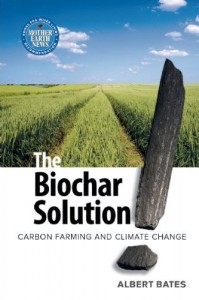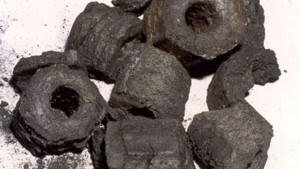 Can biochar singlehandedly save the world from all of its carbon dioxide, global warming woes? Well, the jury is still out but there may be some potential. This I learned from reading the book, “The Biochar Solution: Climate Farming and Climate Change,” by Albert Bates. First, I should explain what biochar is. Biochar is charcoal, a cellulosic material that has been pyrolyzed (to pyrolyze something you burn it a low oxygen environment, such as a kiln, burning off everything but the carbon). The resulting charcoal is black and largely devoid of any nutritional value, yet it can be burned in a high oxygen environment without producing much smoke. These attributes make it a good option for burning in cooking stoves.
Can biochar singlehandedly save the world from all of its carbon dioxide, global warming woes? Well, the jury is still out but there may be some potential. This I learned from reading the book, “The Biochar Solution: Climate Farming and Climate Change,” by Albert Bates. First, I should explain what biochar is. Biochar is charcoal, a cellulosic material that has been pyrolyzed (to pyrolyze something you burn it a low oxygen environment, such as a kiln, burning off everything but the carbon). The resulting charcoal is black and largely devoid of any nutritional value, yet it can be burned in a high oxygen environment without producing much smoke. These attributes make it a good option for burning in cooking stoves.
But Bates believes the real value of biochar lies in that it has a unique ability to condition soil. Bates explains that if it is turned in a nutrient pile and then tilled into the ground, it immediately becomes colonized by soil microbes. These microbes attract fungi, which connect to the roots of the plants, carrying nutrients to the place they are most needed. Biochar is also a water solution – it provides a reservoir and conduit for soil moisture, soaking up water from oversaturated areas and moving it to dyer areas (it can also be used to purify water). Bates says that one gram of charcoal has the surface area of one small house, or 1,000 to 2,500 square meters, because of all its micropores. In terms of soil health, after several years, biochar helps soil return to its natural state and eliminates the need for inputs such as nitrogen or phosphorous – another major environmental benefit.
There is also a connection between biochar and biofuels. When converting biomass to biofuels, not all of the biomass is consumed. At this point, the remaining biomass can be burned and turned into biochar and then the biochar can be tilled into the biomass fields to aid in soil sustainability. In this example, biochar becomes both a biofuels and agriculture solution.
There are several views of biochar one being those who truly believe that biochar alone can reduce CO2 emissions faster and more completely than any other solution. Bates writes, “…humans can alter the atmosphere to take us back to pre-industrial carbon levels – without risky, short-lived, and costly geoengineering gambits such as space mirrors, sulfur aerosols, and fish-suffocating plankton blooms. All we have to do is plant trees, build terra preta soils, and organically store carbon in our planet’s terrasphere instead of in its atmosphere.” Terra preta soils are very dark, fertile soil found in the Amazon Basin that were created using a mixture of charcoal, bone and manure.
 It sounds so simple doesn’t it? Bates defends his view through a historical look at terra preta soils and biochar through the ages. He then provides research and offers a plan to begin sequestering carbon through carbon farming. Oh, and I should mention that biochar supporters believe one ton of biochar can sequester 3 tons of CO2 for at least 1,000 years or more.
It sounds so simple doesn’t it? Bates defends his view through a historical look at terra preta soils and biochar through the ages. He then provides research and offers a plan to begin sequestering carbon through carbon farming. Oh, and I should mention that biochar supporters believe one ton of biochar can sequester 3 tons of CO2 for at least 1,000 years or more.
Ultimately Bates believes that at this late hour there is still hope and his solution, “It would likely involve some combination of biochar, carbon farming, tree planting, and redesign of the built environment and energy systems to be carbon-negative. I cannot imagine any alternative that excludes those strategies that would remain viable for very long.”
So there you have it. It’s Earth Day on Friday and many people like to plant trees. This year, when you plant your tree, add a little biochar. Who knows. If enough people plants trees using biochar, it just might save the world.

